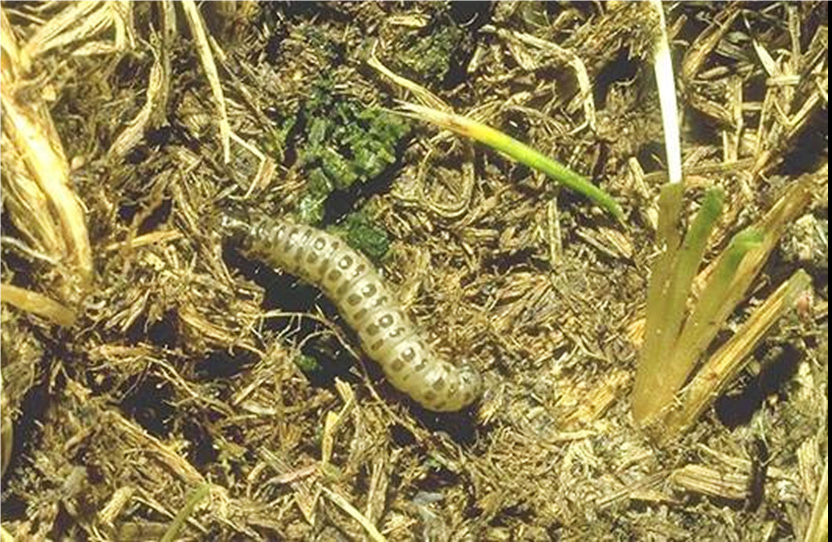Sod webworms are the caterpillar stage of small moths, from the genera Crambus and Herpetogramma. Adult moths are about 1" long, tan-colored, and are often seen flying about the lawn in jerky, short flight. Full-grown larvae (caterpillars) are 3/4" long, brown or gray with spots. The larvae construct silk-lined tunnels in soil or thatch, but come out to the surface at night to feed on grass.

Michigan State University.
Life Cycle
Spring: When the weather warms up, the overwintering caterpillars resume feeding on grass. Damage is first observed in late-June or July.
Summer: Adults or moths appear in July, mate, and lay eggs. The larvae of these moths then cause damage in August.
Fall: Adults appear again in September, mate, and lay eggs. The larvae of these eggs overwinter in the soil.
Damage
The damage caused by sod webworms shows up first as small, irregular brown patches. Flocks of birds seen on the turf are a good indicator of the presence of sod webworms. Birds make probing holes into the turf as they search for caterpillars, which can cause significant damage.
Management
IPM Strategies:
- Monitoring - To sample for sod webworms, look carefully at the damaged area for silken tunnels. Alternatively, mix one tablespoon of liquid dish-washing detergent or 1/4 cup of powdered detergent with a gallon of water. Apply this liquid to one square yard (nine square feet) of turf. The soap irritates webworms and forces them to the surface. Most caterpillars respond to the soapy solution within two to five minutes. This technique is particularly helpful for determining what stages (sizes) of caterpillars are present.
- Biological Control - Bacillus thuringiensis var. kurstaki, a bacterium which produces a toxin and paralyzes the gut of the caterpillar, is available commercially for use on turf. An entomopathopenic nematode, Steinernema carpocapsae, is also available. Field trials indicate that this nematode, available commercially in a variety of formulations, can reduce caterpillar populations significantly. The nematode is very vulnerable to desiccation, so it is important to keep it away from excessive heat and dry conditions.
- Chemical Control - For best results, apply insecticides in late afternoon or early evening when larvae are active.
Consult your county Agricultural Field Specialist for specific pesticide recommendations.

Stop! Read the label on every pesticide container each time before using the material. Pesticides must be applied only as directed on the label to be in compliance with the law. Contact the Division of Pesticide Control at (603) 271-3550 to check registration status. Dispose of empty containers safely, according to New Hampshire regulations.
Download the resource for the complete factsheet.
